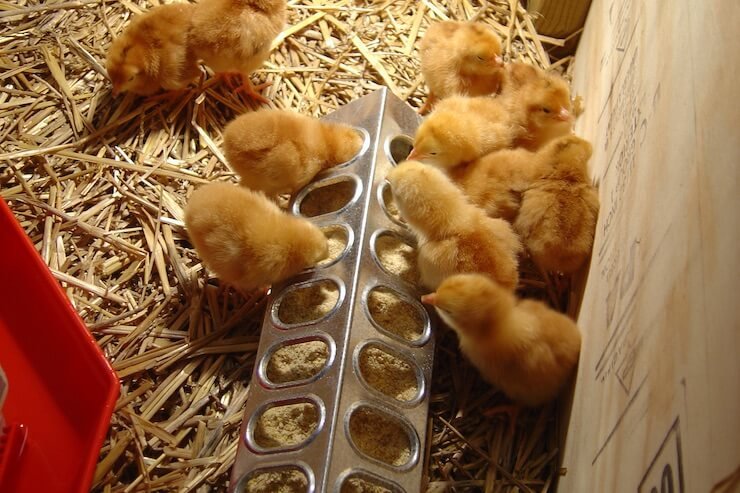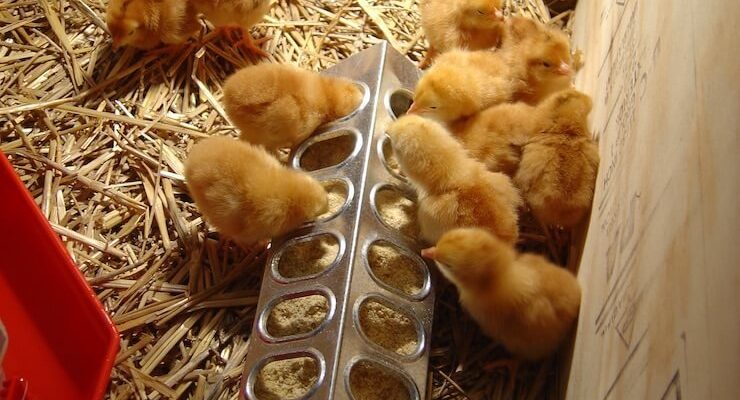
To get started, you’ll want to set up a proper brooding area where your chicks can thrive. This involves more than just a cozy corner; it’s about making a space that mimics their natural habitat while ensuring they stay safe and warm. Get ready to learn some essential tips about brooding setups and feeding routines that will help your chicks flourish.
Understanding the Brooding Setup
Creating a comfortable brooding setup is crucial for your baby chicks’ health. Imagine this space as their first home—a sanctuary where they can grow and explore. You’ll want to choose an area that’s warm, safe, and easy to clean. A simple brooder can be made from a plastic tub, a cardboard box, or even a kiddie pool. Just make sure it’s tall enough so the chicks can’t jump out, but not so high that they feel insecure.
One important thing to consider is the temperature. Baby chicks need a warm environment to thrive, usually around 90-95°F (32-35°C) during their first week. As they grow, you can gradually reduce the temperature by about 5°F each week. You can use a heat lamp or a brooder plate to provide this warmth, and make sure to have a thermometer inside the brooder to keep a close eye on the heat.
Additionally, the brooder should have enough space for all your chicks. A good rule of thumb is to provide about 0.5 square feet per chick during the first few weeks. As they grow, they’ll need more room, so if you plan on keeping them for several months, consider upgrading to a larger space or separating them into different brooders.
Essential Brooder Supplies
To make your brooding space functional and safe, here are some essential supplies you’ll need:
- Heat source (lamp or brooder plate)
- Thermometer
- Wood shavings or straw for bedding
- Chick waterer
- Chick feeder
- Food (starter feed designed for chicks)
Each item plays a role in keeping your chicks comfortable and nurtured, so don’t skip any of them! For bedding, avoid using cedar shavings as they can emit harmful oils. Instead, opt for pine shavings or straw as they’re safer and help control odors.
Setting Up the Temperature and Ventilation
You might be wondering just how important temperature and ventilation are for your baby chicks. It’s critical! Too much heat can lead to dehydration, while too little can make them cold and sick. Using a heat lamp is common, but make sure it’s securely mounted and out of reach of the chicks to prevent any accidents.
As for ventilation, it’s essential to keep the air fresh while protecting the chicks from drafts. You can achieve this by having some small openings in your brooder that allow for airflow without letting in cold air. Proper air circulation helps reduce humidity and prevents respiratory problems. It’s a balancing act, but your attention to detail here will pay off with healthy chicks.
Choosing the Right Feed
When it comes to feeding your baby chicks, quality is key. You’ll want to start them on chick starter feed, which is specially formulated to meet their nutritional needs during the first several weeks of life. This feed is usually high in protein to support their rapid growth, typically containing about 18-20% protein.
Chick starter feed comes in crumble or pellet form, but many people prefer crumble since it’s easier for tiny beaks to eat. Be sure to provide fresh feed daily, as stale food can lead to health issues. It’s also important to ensure that the feed is appropriate for their age; avoid feeding them layer feed until they’re older, as it contains too much calcium for young chicks.
Supplemental Nutrition
Beyond starter feed, you might want to consider offering some supplemental nutrition to your chicks. Fresh greens, like spinach or clover, can be a great addition to their diet as they grow. Just make sure to introduce these foods gradually to avoid any digestive upsets. Another option is to sprinkle a little bit of chick grit in their feed, which helps them digest food properly.
Also, clean, fresh water should always be available. Baby chicks drink a surprising amount of water, so make sure their waterer is shallow enough to prevent drowning. If you find your chicks are getting their bedding wet, consider using a waterer that helps minimize spills.
Monitoring Growth and Behavior
As your chicks grow, it’s essential to keep an eye on their behavior and overall health. You might be surprised at how lively they can be! Healthy chicks are curious and active, and they’ll spend their time pecking at food and exploring their environment. If you notice any signs of lethargy or abnormal behavior, it might be time to consult a vet.
Regularly check their feathers and skin for signs of pests or diseases. It’s also important to monitor their growth. Ideally, your chicks should gain about 0.1 to 0.2 pounds per week. If they seem to be lagging behind, a change in diet or additional warmth might be necessary.
Additionally, be aware of their social dynamics. Just like us, chickens have personalities, and sometimes certain chicks may establish themselves as dominant. Keep an eye on interactions and ensure that all your chicks have access to food and water without being bullied.
Cleaning and Maintenance
Keeping your brooder clean is essential for the health of your chicks. This means regularly changing the bedding and removing any waste to prevent disease. You don’t need to clean everything daily, but a quick spot clean can go a long way in keeping their environment safe.
When changing bedding, try to do so gently to limit stress on the chicks. If you’re using a deep litter method, where you add fresh bedding over time, be sure to turn the litter every couple of weeks. This encourages decomposition and controls odors, creating a healthier environment for your chicks.
Remember to disinfect feeders and waterers regularly, too. A simple solution of vinegar and water can help prevent the growth of harmful bacteria. Keeping things tidy makes a huge difference in your chicks’ health.
Preparing for Transition
As your chicks grow into adolescents, they’ll eventually outgrow their brooder. This usually happens at around six weeks of age, depending on the breed and conditions. At this point, it’s time to think about transitioning them into a larger space, like a coop or outdoor run.
Before moving them outside, ensure their new home is predator-proof and provides adequate shelter. They’ll still need a heat source, especially during cooler months, but by the time they’re about 8-10 weeks old, they should be feathered out enough to handle the temperature changes.
You’ll also want to introduce them to their new environment gradually. Start by letting them explore the coop for short periods while monitoring their behavior. This way, they’ll feel more comfortable and less stressed as they transition to their new home.
In conclusion, caring for baby chicks is a rewarding experience filled with learning and joy. By providing the right brooding setup and nutritious feed, you’ll be setting them up for a happy, healthy life. Remember, attentive care during these early weeks lays the foundation for strong, thriving chickens in the future. Enjoy the journey of raising your little flock!

